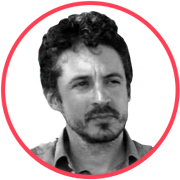The Farm Family: Animals in the project of Rob MacInnis

37 years oldRob MacInnis,
Based in Brooklyn. Graduated from the Rhode Island School of Design in 2005. His work has been showcased in Ottawa, Toronto, Berlin and NYC.
For me it all began when I took a photograph of a donkey in one of my undergraduate classes. The photo ended up coming back into my practice after I graduated, when I was ruminating on themes of exploitation and the idea of manufacturing identity.
The basis of the project was a quite simple approach of treating animals not as our subjects but as their own living beings. I firmly believe that animals are not ours to exploit or abuse. It’s a difficult task – to depict an “animal culture” because humans exist outside of it. We naturally imbue the animals with our own ideas, emotions, thoughts etc. Photography appears to be such a simple medium – immediate and forthright, and I tried to play with how to make photographs that, once finished, would exist as a critique of our treatment of animals. The feelings these images provoke are strong. No one’s emotions are ever wrong.
{
“img”: “/wp-content/uploads/2014/07/photo_01.jpg”,
“alt”: “Farm Family 1”
},
{
“img”: “/wp-content/uploads/2014/07/photo_02.jpg”,
“alt”: “Farm Family 2”
},
{
“img”: “/wp-content/uploads/2014/07/photo_03.jpg”,
“alt”: “Farm Family 3”
},{
“img”: “/wp-content/uploads/2014/07/photo_04.jpg”,
“alt”: “Farm Family 4”
},
{
“img”: “/wp-content/uploads/2014/07/photo_05.jpg”,
“alt”: “Farm Family 5”
},
{
“img”: “/wp-content/uploads/2014/07/photo_06.jpg”,
“alt”: “Farm Family 6”
},
{
“img”: “/wp-content/uploads/2014/07/photo_07.jpg”,
“alt”: “Farm Family 7”
},
{
“img”: “/wp-content/uploads/2014/07/photo_08.jpg”,
“alt”: “Farm Family 8”
},
{
“img”: “/wp-content/uploads/2014/07/photo_09.jpg”,
“alt”: “Farm Family 9”
},
{
“img”: “/wp-content/uploads/2014/07/photo_10.jpg”,
“alt”: “Farm Family 10”
},
{
“img”: “/wp-content/uploads/2014/07/photo_11.jpg”,
“alt”: “Farm Family 11”
},
{
“img”: “/wp-content/uploads/2014/07/photo_12.jpg”,
“alt”: “Farm Family 12”
},
{
“img”: “/wp-content/uploads/2014/07/photo_13.jpg”,
“alt”: “Farm Family 13”
},
{
“img”: “/wp-content/uploads/2014/07/photo_14.jpg”,
“alt”: “Farm Family 14”
}
The question of identity is a very complicated one. Where does an identity exist, if not in the mind of the thing and those who confront it? How much does interaction, communication, presentation, relationship play into what constitutes identity? We each look at any given thing in a different way, due to our perspective. Does this mean the identity of a thing shifts depending on who is looking? It starts to get wonderfully philosophical, and these philosophical ruminations are all I was ever trying to bring up.
I’m not sure how the Farm Family project will be developing with time, but I’m slowly collecting materials for a new exhibition – hoping to open it in the fall or spring.
I find my subjects in various locations. From Nova Scotia (Canada – editor’s note), Ontario, Providence RI, New York to California. Typically at a farm close to where I live at any given time.
Throughout the encounter you can’t manage an animal, it manages you. You simply spend time, come to an understanding, get to know them, and then they start to trust that you won’t hurt them. Eventually, they are open to at least standing in the right damn spot.
I have always taken interest in the fates of my objects. Those fates are short-lived. Donkey’s are naturally partners. Not in a sexual way at all, but they will always bond with one other donkey and be partners who always want to be near. On a farm I photographed at, there were two partner donkeys who lived together and when one died, the farmer – who was unaware of this bonding, – unwittingly decided to just bury the dead donkey where it lied, which is usually the easiest thing to do. The other donkey never knew where its partner went and therefore was unable to grieve. It sat on the ground over the grave and starved itself, waiting for its partner to return. The lives of animals are rarely full of happy circumstances.
{
“img”: “/wp-content/uploads/2014/07/photo_15.jpg”,
“alt”: “Farm Family 15”
},
{
“img”: “/wp-content/uploads/2014/07/photo_16.jpg”,
“alt”: “Farm Family 16”
},
{
“img”: “/wp-content/uploads/2014/07/photo_17.jpg”,
“alt”: “Farm Family 17”
},{
“img”: “/wp-content/uploads/2014/07/photo_18.jpg”,
“alt”: “Farm Family 18”
},
{
“img”: “/wp-content/uploads/2014/07/photo_19.jpg”,
“alt”: “Farm Family 19”
},
{
“img”: “/wp-content/uploads/2014/07/photo_20.jpg”,
“alt”: “Farm Family 20”
},
{
“img”: “/wp-content/uploads/2014/07/photo_21.jpg”,
“alt”: “Farm Family 21”
},
{
“img”: “/wp-content/uploads/2014/07/photo_22.jpg”,
“alt”: “Farm Family 22”
}
Do you want to do photography? Then follow the advice of musician Jeff Tweedy who said: “Just sing what you feel. Don’t let anyone say it’s wrong.”In all honesty, I don’t know what photos I like to take. The stuff I’m always attracted to is the stuff I can’t quite figure out. Something that is meaningful because it relates much of the difficulty of existing in this world.
Promoting photo projects is rather difficult, but people like to help you a lot. I’m represented by Katharine Muhlerin Contemporary Art Projects in Toronto and New York. I used to enter numerous contests, but their exorbitant entry fees made me ratchet that back quite a bit.
Presently, I’m pursuing a variety of things. Recently, I was accepted into the Arctic Circle Residency. I’ll be joining two dozen other artists and sailing in the Arctic circle on the tall ship, Antigua. I’m looking to try out some serious experiments, some hair brained schemes, some hijinx. Making temporary installations in the forest was something I got into during my MFA program at the Rhode Island School of Design. I hope to push those projects further.
New and best




